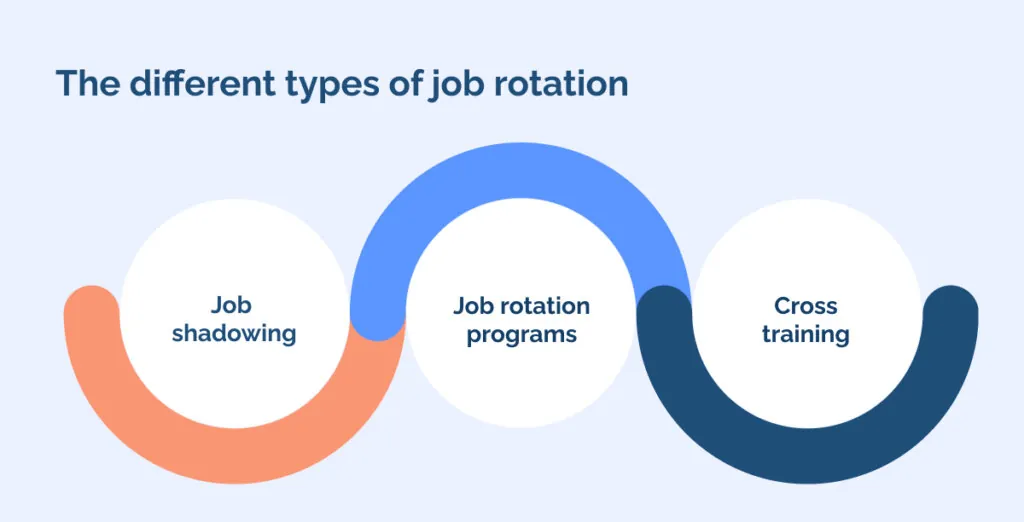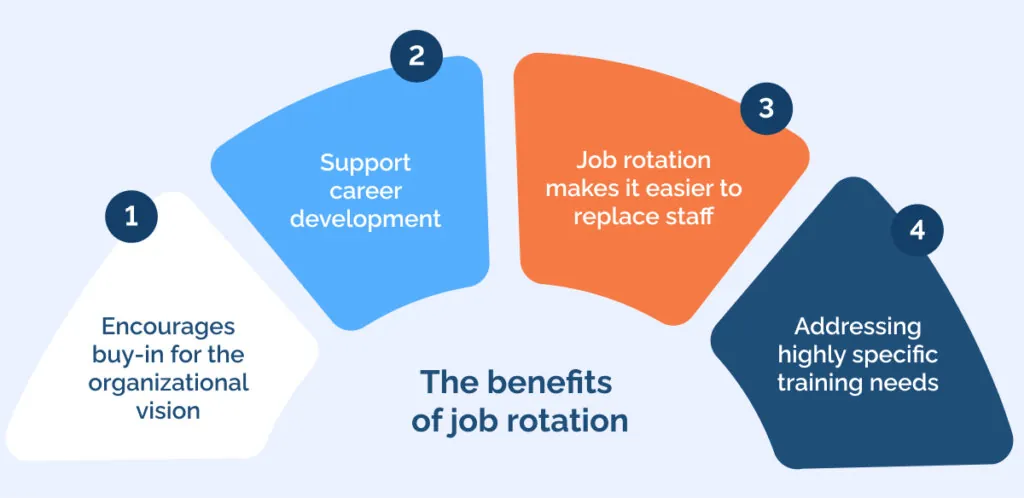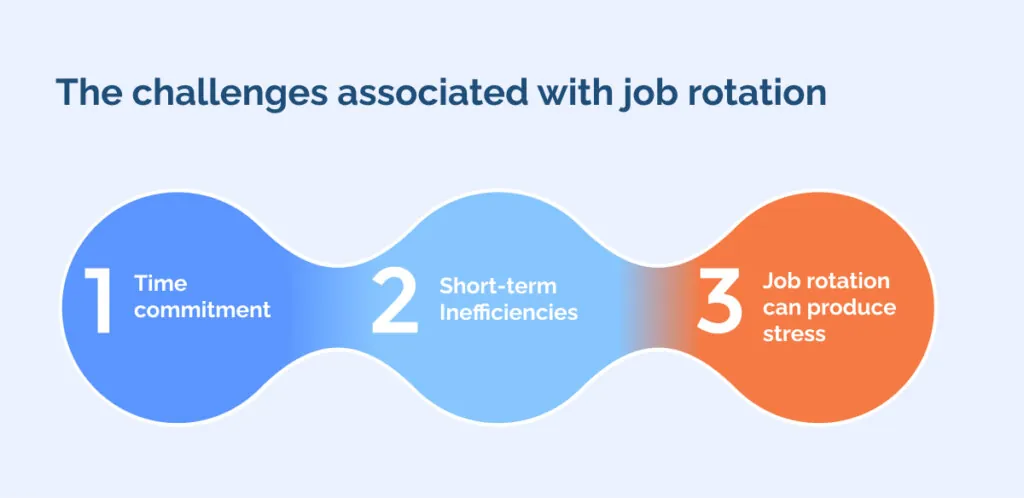
Job rotation is a hallmark of the best business training programs. As a training technique, it gives participants the challenges they need to grow, adapt, and flourish in complex and multifaceted businesses. It’s certainly not the easiest training method. But if you can find the right approach, the right candidates, and the right oversight, it could transform your company-wide development programs.
This article will introduce you to the varied situations in which job rotation can make a difference. It will:
- Define the practice of job rotation;
- Explain the different methods of job rotation;
- Provide example and use cases of real-life situations;
- Explore the benefits and challenges of training via job rotation.
In today’s business world, a majority of HR leaders are feeling pressure from C-suite executives to deliver outstanding training programs (as Gartner research has discovered). Job rotation is not a quick fix solution: but it could be a vital way to revitalize your overall training strategy.
What is job rotation?

Job rotation is a strategic approach to training in which employees work in different roles within an organization. You can implement job rotation in various ways, ranging from short-term shadowing experiences to longer periods of secondment. Job rotation serves as a tool for talent development, succession planning, and enhancing organizational agility.
Commonly found in sectors like manufacturing and medicine, job rotation is applicable in many business environments. larger companies with diverse departments, clear career progression hierarchies, and management teams overseeing this diversity can all enjoy the positive outcomes of job rotation.
It particularly benefits organizations that emphasize cross-functional collaboration or have interlocking chains of responsibility. This practice is not limited to specific organizational levels; it can be applied from entry-level staff to top-level executives.
Both employers and employees stand to gain from job rotation. For individuals, it offers the opportunity to develop a diverse set of experiences and skills, introducing new challenges that can enhance job satisfaction. While job rotations require meticulous organization, the investment is often justified as they serve as a unique method for bringing employees up to speed on various functions within a company, significantly improving overall competency.
However, job rotation is not a one-size-fits-all solution. Urgent tasks, roles with professional standards for safety, and organizations with limited career paths may not be suitable for job rotation. In such cases, alternative approaches may be more appropriate.
What are the different types of job rotation?

In this section, we’ll introduce three different types of job rotation: job shadowing, a traditional job rotation program, and cross-training. Each of these requires different levels of commitment, engagement, and organization; and each type can itself be adapted to many different situations.
While you’re looking at these types of job rotations, here’s something to keep in mind. One of the biggest challenges is workforce planning. Whether you are introducing a large or small job rotation scheme, you need to make sure that enough employees are available to cover every task. This is a tall order! Fortunately, tools like monday.com are now on hand to help managers plan their job shadowing exercises effectively.
Here we will take a take a closer look at the three different types of job rotation:
- Job shadowing
- Job rotation programs
- Cross-training
Job shadowing
Job shadowing is a training and mentoring approach in which an individual, typically a new or less experienced employee, observes and learns from a more experienced colleague by spending time with them during their daily work activities.
The purpose of job shadowing is to provide the observer with firsthand insights into the responsibilities, tasks, and expectations associated with a particular job or role
How to implement job shadowing
In some cases, you will be able to implement job shadowing as an informal method of continuous learning.
Within one small business unit, it’s quite easy to make these arrangements. But if you plan to make shadowing a bigger part of your human resources strategy, you should go through the following steps:
- Decide a set of guidelines for your job shadowing program. Who will it apply to? What is the objective of the task? This helps you decide who will be available to participate – both as host and as mentors.
- Match participants with hosts in a thoughtful and strategic way. Consider the participants’ career interests, goals, and areas for development. Similarly, match hosts who are willing and able to provide a valuable and informative experience.
- Conduct an orientation session for both participants and hosts before the job shadowing begins.
- Clearly communicate the purpose of the program, expectations, and any logistics involved.
- Address any questions or concerns to ensure everyone is on the same page.
Tips for success
When you’re trying to implement or improve job rotation in your organization, take the following tips on board:
- Job shadowing can sometimes feel short-term and ad hoc. That’s not a problem. But you should still try to integrate job shadowing with your company’s strategic goals.
- Be prepared to troubleshoot along the way. If your candidates and mentors are struggling with the agreement, your HR team should step in to have some difficult conversations.
- Scheduling is likely to be the hardest part of the job shadowing program. Address any logistical challenges, such as scheduling conflicts or resource constraints. Work with relevant departments to streamline logistics and ensure a smooth implementation of the job shadowing program.
Who’s it for?
Job shadowing can be useful for staff at all levels of an organization. However, it’s commonly connected with people who want to become leaders.
Job rotation programs
A rotation program, in the context of training and job rotation, is a structured initiative designed by organizations to systematically move employees through different roles, departments, or functions within the company.
The program is aimed at providing participants with a well-rounded experience, enhancing their skills, and preparing them for a variety of responsibilities within the organization.
How to implement job rotation
Organizing a job rotation program will always be a big deal. From the point of view of company-wide human resources, consider the following steps:
- Identify an area where job rotation could best improve your company. That might be a particular business unit, a particular type of employee, or a particular physical site of the company.
- Consult with representatives from all stakeholders. You need buy-in from all the relevant leaders – otherwise, the recruits won’t get anything from the experience. You may need to arrange additional training for managers of rotating staff.
- Recruit participants for the program. At first, this may be by invitation. Alternatively, you could internally advertise for the opportunity.
- Monitor and evaluate. A rotation program isn’t all about fun and games. If you have a clear set of objectives and KPIs and a good feedback loop, you’ll be able to tell whether the program is actually achieving anything.
Tips for success
In the process of organizing your job rotation scheme, think about these additional tips for success:
- Acknowledge the challenges of job rotation programs. Organizing a successful rotation program can be really difficult! So don’t underestimate the potential challenges that may arise. Acknowledge the complexity of moving employees quickly through different roles and anticipate potential issues.
- Make soft skills training a prerequisite. Your participants might face some challenging situations through their rotations. To ward off these challenges, include soft skills training in the program to equip participants with the right interpersonal skills. Effective communication, teamwork, and adaptability are essential for building positive relationships during rotations.
- Establish dedicated HR support. Assign specific HR staff with a clear responsibility for overseeing the job rotation program. Having a designated point of contact for participants and managers facilitates efficient communication, problem-solving, and ensures a streamlined implementation process.
Who’s it for?
In white-collar workplaces, job rotation is most useful for high-potential candidates. Whether that’s for fast-track recruits, executive leadership, or building a pool for succession planning, job rotation helps prospective candidates excel.
Cross training
In cross-training, training employees learn tasks or responsibilities outside of their primary job roles. Unlike traditional job rotation, where employees move between distinct roles or departments, cross-training focuses on developing a broader skill set within the same team or functional area.
How to implement cross-training
You can implement cross-training in several different ways. Depending on your needs, you might be looking for ad hoc or self-directed activities, structured cross-training modules, or a wide-ranging cross-training program.
- With ad hoc or self-directed activities, team members take the initiative to learn about different roles or functions within the organization based on their interests or immediate needs. This flexible method allows individuals to tailor their learning experiences to their development goals.
- Structured cross-training modules involve creating a curriculum with predefined learning paths, incorporating a mix of training methods such as classroom sessions, workshops, and hands-on experiences. The structured cross-training modules ensure a systematic and organized progression, allowing participants to acquire comprehensive skills across different departments or functions.
- A formalized cross-training program is a deliberate organizational initiative aimed at systematically exposing employees to various roles. This method involves a planned approach where management identifies key skills and knowledge areas, matching employees with relevant training opportunities
Who’s it for?
Cross-training is useful for any role that requires a varied and flexible skillset. It may be valuable for leadership teams, but it is also useful within technical teams.
The practical applications of job rotation
Fast-tracking graduate recruits
Job rotation is a valuable support mechanism for graduate recruits stepping into managerial roles. When a new person joins the company, job rotation gives them a comprehensive overview of the entire organizational system. This allows fresh recruits to gain exposure to various roles and functions, providing a well-rounded understanding of the company’s operations without prematurely committing them to a specific career path.
Job rotation serves as an ideal platform for graduate recruits to explore their strengths, interests, and potential areas of expertise within the organization.
Additionally, this exposure to diverse functions may seamlessly feed into leadership development, as the rotational experience equips them with a broad perspective, adaptability, and the skills necessary for effective managerial responsibilities in the future.
Leadership development
As staff progress up the management ranks of an organization, a comprehensive understanding of every aspect of the business becomes imperative for effective leadership. Great leaders cannot afford to be siloed within their specific niche; instead, they must cultivate a holistic view of the organization’s activities.
Job rotation plays a pivotal role in achieving this goal.
By exposing emerging leaders to diverse roles and functions within the company, job rotation facilitates a firsthand exploration of different facets of the business. This hands-on experience not only broadens their skill set but also nurtures a strategic mindset, fostering adaptability and a deeper appreciation for the interconnectedness of various organizational functions.
Knowledge transfer
Job rotation supports the exchange of explicit and tacit knowledge. This collaborative training approach ensures that critical knowledge is not siloed within specific roles, reducing dependency on individual experts.
It accelerates the onboarding of new members, strengthens team cohesion, and enables cross-functional collaboration. Ultimately, cross-training encourages a culture of continuous learning, positioning the team as versatile, cohesive, and well-prepared for dynamic challenges within the organization.
What are the benefits of job rotation?

We’ve already mentioned many benefits of job rotation: its power in building a collaborative spirit, providing specialist training, and breaking down knowledge silos. In this section we will look at a few more benefits of job rotation: buy-in for organizational vision, supporting career development, reducing the challenge of replacing staff, and resolving the most specific training needs.
Encourages buy-in for the organizational vision
Forms of job rotation offer a unique way of achieving a multifaceted perspective of the company.
As employees navigate through various responsibilities, they develop a comprehensive view of the organization’s goals, values, and interconnected operations. This firsthand experience not only cultivates a stronger commitment to the organizational vision but also instills a sense of ownership and alignment, as individuals recognize their integral role in achieving the shared objectives.
Support career development
Job rotation gives participants a unique opportunity for career development.
They give employees the chance to get a comprehensive understanding of the organization’s intricacies, developing their skills for effective job performance and networking across various departments. Employees cultivate both general and job-specific skills, honing their abilities to collaborate and contribute more effectively.
Whether focusing on management or technical skills, the benefits are manifold. Positive career development, fostered by job rotation, is tied to overall job satisfaction, a key factor in retaining valuable talent.
Job rotation makes it easier to replace staff
Job rotation supports seamless staffing transitions at every level of the organization. When many staff members have been through a job rotation program, the organization has a pool of people with the skills and knowledge needed to step into specific roles in the future.
When specialist staff members depart, having someone already familiar and trained through job rotation becomes a proactive solution for a swift replacement. Acknowledging the inevitability of turnover, job rotation serves as a practical tool to mitigate disruptions, ensuring that key positions are consistently filled with individuals well-prepared to take on the responsibilities.
Succession planning is just one aspect of this benefit. With a good job rotation program, you can rest assured that there are staff to support your company’s work.
Addressing highly specific training needs
Job rotation proves especially beneficial in addressing highly specific training needs that may not be adequately met through conventional training programs. In instances where knowledge transfer requires skills development not covered by existing training programs, job rotation emerges as a viable solution.
This is particularly evident in specialized fields such as lab-based research or when helping IT staff familiarize themselves with the unique technologies used in a specific department. In such cases, the immersive nature of job rotation allows individuals to gain hands-on experience and expertise, filling the gaps that may exist in more traditional training approaches.
By facilitating direct exposure to the intricacies of different roles, job rotation becomes a tailored strategy for honing skills that are both specific and essential to the diverse requirements of the organization.
What are the challenges associated with job rotation?

Despite all the benefits, job rotation is not for everyone. Even with the best implementation of a job rotation program, there are downsides and challenges that everyone should keep in mind.
The major take-home from this section is simple. To avoid negative consequences of job rotation, use this training method in a focused and specific way. It might be wisest to reserve it for staff who are generally keen to learn more about an organization.
Time commitment
Introducing job rotation poses a significant time commitment, particularly during the initial stages of setting up a comprehensive rotation scheme. The process demands substantial effort from any managers involved, as well as the oversight of the HR department.
As a result, it’s important to consider the overarching strategy during the setup phase. Organizations need to weigh up the investment in planning against the anticipated outcomes: time and resources are fundamental to the program’s overall effectiveness and long-term success.
Despite the challenges, acknowledging the importance of thorough planning is crucial for realizing the full potential of a job rotation initiative.
Short-term Inefficiencies
In the long term, job rotation can be a highly effective mode of training – giving participants memorable experiences that stay with them in their career journeys.
However, in the short term, a job rotation program can directly cause inefficiencies. When participants adapt to new responsibilities, they simply won’t know the best way to manage a particular situation. Even with the best intentions, many participants will make business processes more time-consuming and less effective than they may usually be.
So, if your company wants to introduce job rotation, you must remember these short-term inefficiencies. In the long run, they will contribute to a smoother and more effective transition in the long run. But a learning curve and adjustment period are inherent to the job rotation process.
Job rotation can produce stress
Job rotation, while a valuable strategy for talent development, is not suitable for every employee. In some situations, it can lead to increased stress among employees. 2021 research on the “ugly side” of job rotation in hotels showed that the wide range of negative feelings that it could produce in employees – including anxiety, anger, and even sabotage behaviors.
Job rotation shouldn’t be imposed on your staff. There are cases where it will work – but others where it won’t. Understanding the potential stressors associated with job rotation is essential, allowing organizations to implement the strategy judiciously and tailor it to situations where it can truly yield positive outcomes.
Could job rotation be right for you?
As we move forward, it’s more important than ever that workers are agile, adaptable, flexible, and highly skilled. If you’re recruiting for a managerial position, it’s almost impossible to find someone who has every bit of relevant experience.
In this context, job rotation is a major investment that could give you the benefits you need. While a full job rotation program (for example, a graduate recruitment scheme) is hard to implement, other opportunities (like informal cross-training) that can introduce a culture of knowledge transfer and learning.
WalkMe Team
WalkMe spearheaded the Digital Adoption Platform (DAP) for associations to use the maximum capacity of their advanced resources. Utilizing man-made consciousness, AI, and context-oriented direction, WalkMe adds a powerful UI layer to raise the computerized proficiency, everything being equal.



